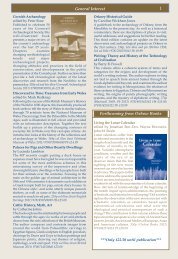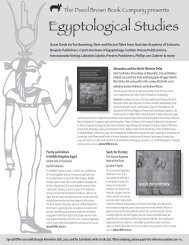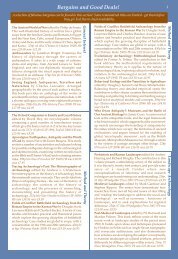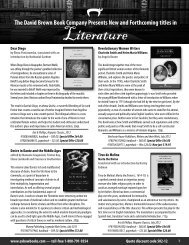New Distributed Titles Fall 2009 - Oxbow Books
New Distributed Titles Fall 2009 - Oxbow Books
New Distributed Titles Fall 2009 - Oxbow Books
Create successful ePaper yourself
Turn your PDF publications into a flip-book with our unique Google optimized e-Paper software.
Franz Steiner Verlag<br />
Hort der Frõmmigkeit – Ort der Verwahrung<br />
Russische Frauenklöster im 16. - 18. Jahrhundert<br />
by Angelika Schmähling<br />
This volume studies the history and function of Russian women’s convents in<br />
early modern times. While rogation and donorship were considered the main<br />
function of the convents’ inhabitants, the convents also served as repositories<br />
for criminal or divorced women and the mentally ill. The author analyzes and<br />
compares the 16th–17th centuries and the 18th century. German text.<br />
212p, 4 b/w illus, 12 tbls, paperback, 9783515091787, $63.00(s), Franz Steiner<br />
Verlag, June <strong>2009</strong>, Quellen und Studien zur Geschichte des Östlichen Europa 75.<br />
Leitbild Europa?<br />
Europabilder und ihre Wirkungen in der Neuzeit<br />
edited by Jürgen Elvert and Jürgen Nielsen-Sikora<br />
Europe has often been ascribed a model (leitbild) function.<br />
While the term can be understood as representing some kind<br />
of ideal, it has also been used to describe a mere notion of guidance.<br />
This volume analyzes the conflicting priorities created by<br />
the ambiguity of the term and clarify its use within the context<br />
of European history. German text.<br />
308p, 8 b/w illus, paperback, 9783515093330, $93.00(s), Franz<br />
Steiner Verlag, May <strong>2009</strong>, Beihefte der Historischen Mitteilungen 74.<br />
Die ‘Lösung’ der kroatischen Frage zwischen 1939 und 1945<br />
Kalküle und Illusionen<br />
by Tvrtko P Sojcic<br />
The Independent State of Croatia, founded in 1941 and disbanded in May 1945, and the<br />
national revolutionary Ustasa organization, are shrouded in myth, the origins of which<br />
go back to Tito’s propaganda. This volume counters with a critical and rational description<br />
of the events, which led to the mutual annihilation of Ustase, Chetniks, and partisans<br />
under the devastating influence of the Great Powers. In untangling the confusing<br />
web of changing coalitions, the author focuses on the motives, tactics and strategies of<br />
participating actors and organizations. German text.<br />
477p, paperback, 9783515092616, $125.00(s), Franz Steiner Verlag, December 2008,<br />
Kulturwissenschaften und Nationalsozialismus<br />
edited by Jürgen Elvert and Jürgen Nielsen-Sikora<br />
The politics of the National Socialists demanded the subjugation of scientific thought<br />
and action to its ideology; thus, the absolute conformity of the sciences and their total<br />
commission within the system. From this perspective, this volume illustrates the role of<br />
the cultural and social sciences within National Socialism, and especially their contribution<br />
to the “societal mobilization” as sought by the “Ritterbusch initiative.” German text.<br />
922p, 9 tbls, hardback, 9783515092821, $176.00(s), Franz Steiner Verlag,<br />
December 2008, Beihefte der Historischen Mitteilungen 72.<br />
modern history<br />
Wie mächtig war der Kaiser?<br />
Kaiser Wilhelm II. zwischen Königsmechanismus<br />
und Polykratie von 1908 bis 1914<br />
by Alexander König<br />
The German emperor Wilhelm II claimed to personally govern<br />
his country. Historical research on the topic is split into two contrasting<br />
views: the “monarchic mechanism” and the “polycracy<br />
of rivaling power centers.” This volume studies both models<br />
and evaluates their validity. German text.<br />
317p, paperback, 9783515092975, $93.00(s), Franz Steiner<br />
Verlag, July <strong>2009</strong>, Beihefte der Historischen Mitteilungen 73.<br />
Der Januskopf des Staates<br />
Warum wir auf den Staat nicht verzichten können<br />
by Rüdiger Voigt<br />
The modern state is Janus-faced. On the one hand, it is the only stable factor<br />
during a time when the foundations of capitalism seem to shake from the destabilization<br />
of banking houses; on the other hand, it interferes with its citizens’<br />
constitutional rights in the name of national security. This volume analyzes the<br />
changes in statehood from the viewpoint of realistic politics. German text.<br />
230p, 20 charts, paperback, 9783515093095, $60.00(s), Franz Steiner Verlag,<br />
April <strong>2009</strong>, Staatsdiskurse 5.<br />
Beihefte der Historischen Mitteilungen 71. Die Logik der Industriepolitik im Dritten Reich<br />
Die Investitionen in die Autarkie- und Rüstungsindustrie<br />
und ihre staatliche Förderung<br />
by Jonas Scherner<br />
Autarchy and armament were at the center of the economic politics of the<br />
National Socialist regime. But how did the state manage to create the desired<br />
industrial capacities? This study demonstrates that investments typically originated<br />
from a voluntary rationality within private industry. German text.<br />
320p, 26 b/w illus, paperback, 9783515091527, $79.00(s), Franz Steiner Verlag,<br />
December 2008, Beihefte der Vierteljahrschrift für Sozial- und Wirtschaftsgeschichte 174,4.<br />
www.dbbconline.com 107

















